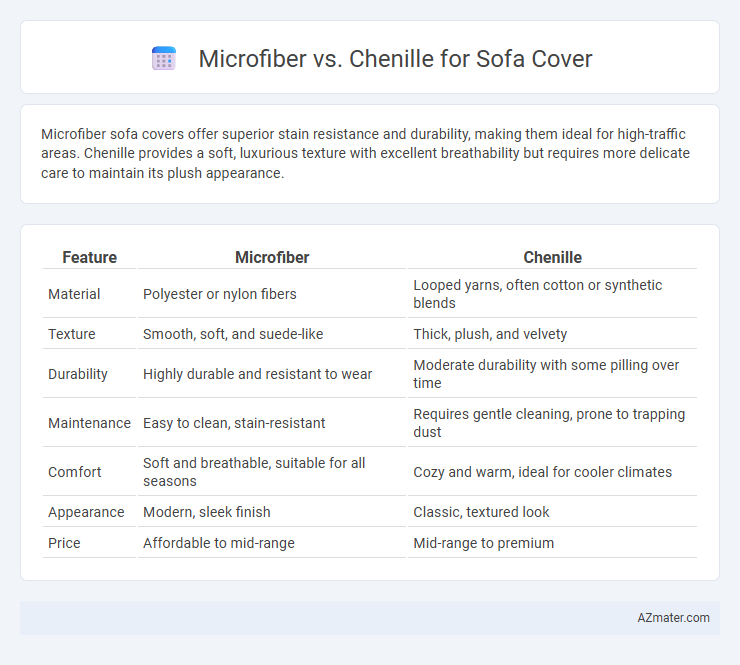Microfiber sofa covers offer superior stain resistance and durability, making them ideal for high-traffic areas. Chenille provides a soft, luxurious texture with excellent breathability but requires more delicate care to maintain its plush appearance.
Table of Comparison
| Feature | Microfiber | Chenille |
|---|---|---|
| Material | Polyester or nylon fibers | Looped yarns, often cotton or synthetic blends |
| Texture | Smooth, soft, and suede-like | Thick, plush, and velvety |
| Durability | Highly durable and resistant to wear | Moderate durability with some pilling over time |
| Maintenance | Easy to clean, stain-resistant | Requires gentle cleaning, prone to trapping dust |
| Comfort | Soft and breathable, suitable for all seasons | Cozy and warm, ideal for cooler climates |
| Appearance | Modern, sleek finish | Classic, textured look |
| Price | Affordable to mid-range | Mid-range to premium |
Introduction to Sofa Cover Fabrics
Microfiber and chenille are popular sofa cover fabrics known for their durability and comfort. Microfiber features tightly woven synthetic fibers that offer stain resistance and easy maintenance, making it ideal for high-traffic areas. Chenille, woven with soft, plush yarns, provides a luxurious texture and warmth while maintaining good durability and color retention.
What is Microfiber?
Microfiber is a synthetic fabric made from ultra-fine polyester fibers tightly woven together, creating a soft yet durable material ideal for sofa covers. Its dense weave makes it highly resistant to stains, water, and wear, ensuring long-lasting protection and easy maintenance on furniture. Compared to chenille, microfiber offers superior durability and stain resistance, making it a practical choice for high-traffic living areas.
What is Chenille?
Chenille is a type of fabric made from tufted yarns that create a soft, fuzzy texture resembling caterpillar fuzz, often used for sofa covers due to its plush feel and durability. Its unique construction involves short lengths of fiber woven between two core yarns, resulting in a velvety surface that enhances comfort and aesthetic appeal. Chenille sofa covers are favored for their luxurious softness and ability to resist wear, making them ideal for cozy, elegant living spaces.
Durability: Microfiber vs Chenille
Microfiber sofa covers offer exceptional durability with resistance to wear, stains, and fading, making them ideal for high-traffic areas and households with pets or children. Chenille, while plush and soft, tends to be less durable due to its delicate fibers, which can pill or fray over time with frequent use. Choosing microfiber ensures long-lasting performance and easier maintenance compared to the more delicate chenille fabric.
Comfort and Texture Comparison
Microfiber sofa covers offer a smooth, soft texture with a suede-like feel, providing excellent comfort and easy maintenance, making them resistant to stains and wear. Chenille covers deliver a luxurious, plush texture with a distinctive raised weave, creating a cozy and inviting surface, though they require more delicate care to maintain softness. Both materials enhance sofa comfort, with microfiber favoring durability and stain resistance, while chenille emphasizes tactile richness and warmth.
Stain Resistance and Maintenance
Microfiber sofa covers exhibit superior stain resistance due to their tightly woven synthetic fibers that repel liquids and prevent easy absorption. Chenille, with its looped yarn texture, tends to absorb spills more readily, making stains harder to remove and requiring frequent cleaning. Maintenance of microfiber is generally easier, as it can often be spot-cleaned with mild detergents, while chenille demands more delicate care, including professional cleaning to maintain its softness and appearance.
Aesthetic Appeal and Color Options
Microfiber sofa covers offer a smooth texture with a subtle sheen that complements modern and minimalist decor styles, while chenille presents a plush, textured surface ideal for creating a cozy and luxurious ambiance. Microfiber is available in a wide array of vibrant colors and solid shades, making it easy to match any interior palette, whereas chenille tends to feature richer, muted tones that enhance warmth and sophistication. Both materials provide varied aesthetic appeal, but microfiber excels in versatility with bold color options, and chenille stands out for depth and tactile elegance.
Price Differences and Value
Microfiber sofa covers typically offer a more affordable price point compared to chenille, making them a budget-friendly choice for many consumers. Chenille covers, while often more expensive, provide a luxurious texture and greater durability, which can justify their higher cost through long-term value. Investing in chenille may result in a softer feel and enhanced aesthetic appeal, whereas microfiber balances cost efficiency with practical stain resistance.
Ideal Usage Scenarios for Each Fabric
Microfiber sofa covers excel in households requiring stain resistance and easy maintenance, making them ideal for homes with pets or children due to their durability and water-repellent properties. Chenille fabric, with its soft texture and luxurious appearance, suits low-traffic living rooms or formal settings where comfort and aesthetic appeal are prioritized over heavy-duty use. Choosing between microfiber and chenille depends largely on lifestyle needs, balancing resilience and plush comfort for optimal sofa protection.
Choosing the Right Sofa Cover for Your Home
Microfiber sofa covers offer durability, stain resistance, and a soft texture, making them ideal for high-traffic areas and homes with pets or children. Chenille covers provide a luxurious, plush feel with rich texture and warmth, enhancing comfort and aesthetic appeal in living rooms with moderate use. Selecting between microfiber and chenille depends on lifestyle needs, balancing durability and ease of maintenance with comfort and style preferences.

Infographic: Microfiber vs Chenille for Sofa Cover
 azmater.com
azmater.com